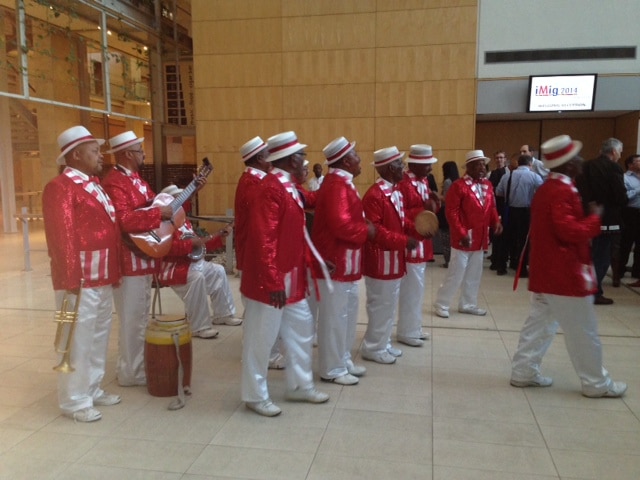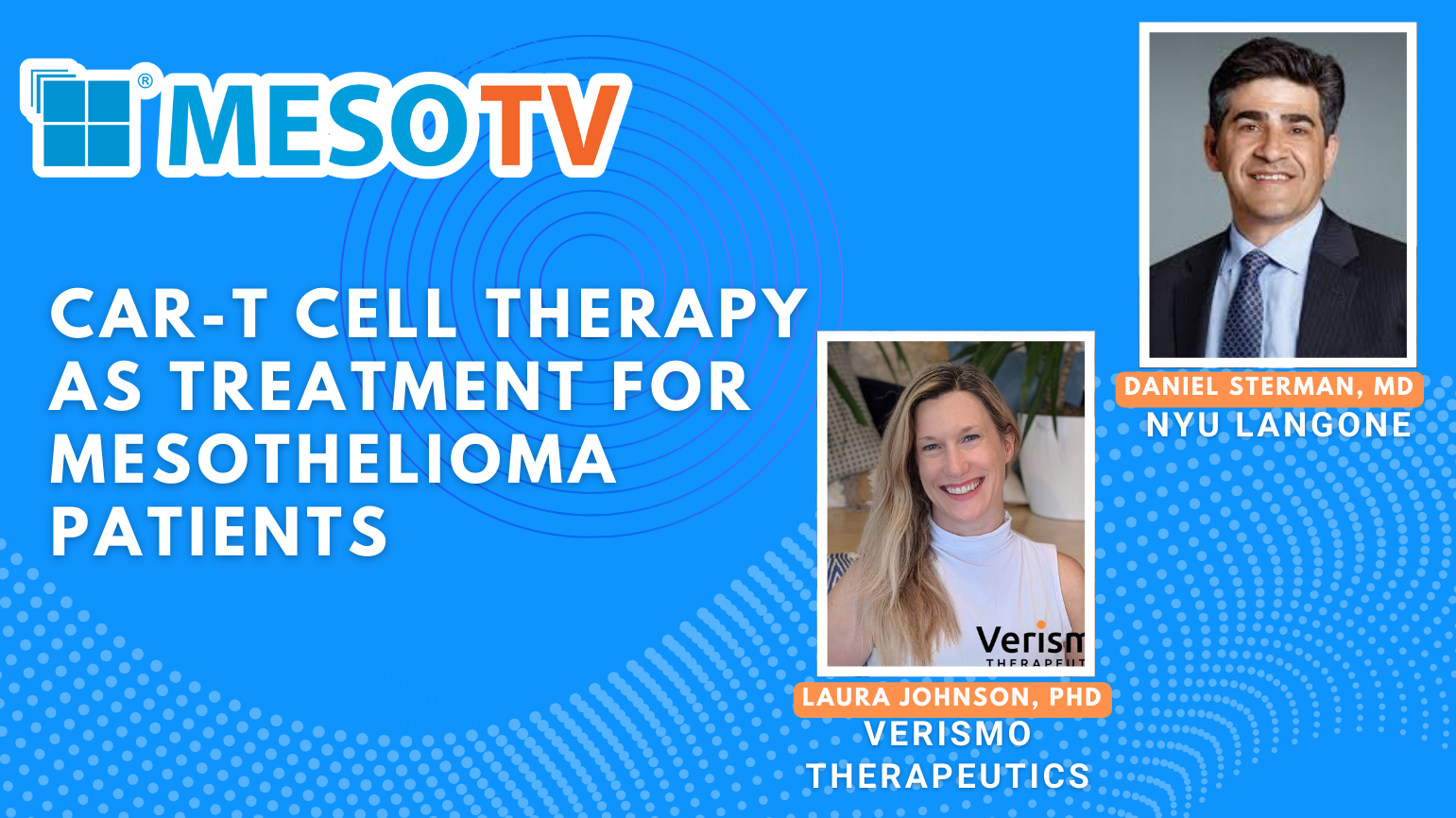 ***The Best of iMig 2014 updates were created by iMig and distributed to conference attendees during iMig 2014. The following is a verbatim re-post of those updates.***
***The Best of iMig 2014 updates were created by iMig and distributed to conference attendees during iMig 2014. The following is a verbatim re-post of those updates.***
In the opening plenary session of iMig 2014, Dr. Jim te Water Naudé and Dr. Steven Mutsaers welcomed close to 300 healthcare professionals to Cape Town, South Africa.
It’s an impressive number of attendees for this somewhat remote but beautiful venue and given iMig’s membership of around 500 members. The assembled group comprises the finest minds in mesothelioma related research, treatment, and advocacy from around the world. It’s quickly evinced as a heavily scientific affair with a fun spirit as Dr. te Water Naudé jokingly threatens to use a vuvuzela horn on speakers who defy their time restrictions.
The initial plenary session focused on several areas of interest to the broad range of delegates traveling to iMig. The opening plenary speakers’ presentations are outlined below as are several key presentations chosen by iMig peers as the “Best of iMig 2014”.
Dr. Constantine Alifrangis Speaks on Next Generation Sequencing in Mesothelioma
Click here to watch Dr. Alifrangis’s Presentation
Dr. Constantine Alifrangis focused on the study of cancer genomes and how it might be used to identify new treatments and individualize care for patients with mesothelioma. These approaches have identified specific genomic alterations in mesothelioma associated with unexpected drug sensitivities in mesothelioma. As for other cancers, study of cancer genomes in mesothelioma has the potential to guide development of novel therapies for this disease. Click here to hear and see more about this work.
Dr. Ravi Salgia presents “From Chaos to Mitochondrial Functionality”
Click here to watch Dr. Salgia’s Presentation
Dr. Salgia summarized efforts from his group to bring mathematical modeling to the study of malignant mesothelioma and how the rules of this theory can be applied to consideration of mutations associated with mesothelioma, suggesting that DNA acts much likes fractals. He emphasized that the fractal dimensionality of mesothelioma cells is dramatically different from that of normal cells and that mitochondrial networks in mesothelioma can also be modeled with fractal analysis. Click here to learn more about this new approach to understanding mesothelioma and the biology of other cancer cells.
Dr. Robert Weinberg speaks on Cancer Stem Cell Targeting Therapies
Click here to watch Dr. Weinberg’s Presentation
Dr. Weinberg focused on the importance of cancer stem cells in mesothelioma. The concept of a stem cell origin of cancer was first described over fifty years ago as a small subset of cells capable of re-initiating a clonal tumor, and there is evidence for both a stem cell origin of mesothelioma, and a stem cell population in the mesothelioma tumor microenvironment. These cells play an essential role in the invasion-metastasis cascade, they are risk to conventional chemotherapy,and are believed to underlie resistance and relapse in mesothelioma. Click here for a summary of the latest information on cancer stem cells in mesothelioma.
Laurie Kazan-Allen Presents on The Global Asbestos Landscape
Click here to hear Ms. Kazan-Allen’s Presentation
Ms. Kazan-Allen emphasized that the battle with mesothelioma is being fought on two fronts: countries where asbestos has been banned and those in which consumption remains legal. In 2014 the asbestos dialogue has become a mainstream discourse encompassing fundamental matters such as human rights, public health, social justice and economic sustainability. Decisions about asbestos use must now be driven by political, social and environmental considerations, not just economics. Click here for a detailed discussion of these critical issues and the “asbestos war”.
Improving outcomes in mesothelioma: an international approach to meeting nurses’ educational needs
Click here for Liz’s Commentary
Effective management of patients with mesothelioma requires large cadres of well-trained nurses in parts of the world in which the incidence of disease is high. The United Kingdom has >2,500 cases of mesothelioma diagnosed each year and nursing education is critical for optimizing care for these individuals. The Royal Marsden School of Cancer Nursing and Rehabilitation in cooperation with Mesothelioma UK has developed an accredited interactive on-line accredited mesothelioma course to help meet this need. The course can be taken by undergraduates and graduate students.
The content of this course is tailored to meet the needs of international students and the curriculum includes two introductory, nine didactic, and three practically focused weeks of training. Content delivered by expert faculty includes global asbestos consumption, signs and symptoms of mesothelioma, diagnosis, treatment, symptom management, and medico legal issues. Patient and carers perspectives and end-of-life issues are also addressed in detail. The course content is focused on the diagnosis/treatment journey of the patient with mesothelioma.
To date, the course has been delivered 5 times to a total of 56 healthcare professionals have completed the course including several international students from Australia, South Africa, Japan, Ireland, and the United States. The course received a Quality in Health Care award in 2012. Two former course participants have gone on to develop similar educational programs in their own countries.
Courses similar to that described in this summary have been established in Australia and Japan.
Nursing collaborations, such as this online educational program, can help fill important gaps in meeting the health care needs of those affected by asbestos- related disease.
Clinicopathological features of patients with malignant mesothelioma in a multicenter, retrospective study – Dr. Manlio Mancoboni
Dr. Mencoboni and his colleagues have focused on understanding factors that predict outcomes for patients with mesothelioma. They carried out a retrospective analysis of 235 patients with mesothelioma who were treated at 4 centers in Italy. These patients were typical of the larger population with mesothelioma: 76.6% were males and they were generally elderly with a median age of 69.6 years. Tumor histology was epitheliod in 82.6% and sarcomatoid in 4% of the cohort.
The treatment histories for these patients were also typical of those for patients with mesothelioma. Surgery was carried out in 20.4% of patients and radiotherapy was performed in 39.6%. In addition, 9.3% of patients underwent trimodal treatment. First-line chemotherapy was administered to 98.3% of the patients in the study cohort and 78% receive pemetrexed-based chemotherapy was administered to 78%. Overall, 68% of patients received second-line chemotherapy and 27% received third-line treatment.
The overall median survival for the patients study was 22.0 months and 19% survived for >36 months. Prognostic factors for survival were identified with univariate and multivariate analyses. Factors significantly associated with survival in univariate analysis were younger age, better performance scores, receipt of radiotherapy or surgery, epithelioid histology, and best response to first-line chemotherapy.
Multivariate analysis confirmed significant independent influences for younger age, surgery, sarcomatoid morphology (shorter survival), and first-line chemotherapeutic treatment (shorter survival vs best supportive care, but only for patients with a poor response to this treatment).
Neoadjuvant Therapy and Surgery- Dr. Raphael Bueno
Standard therapy for malignant pleural mesothelioma (MPM) has not advanced significantly in the past 10 years and new approaches to treatment are needed. Results from genomic studies indicate that mesothelioma is not a “disease of mutations” and those associated with disease are well known. These studies have shown that MPM is associated with changes in copy number, most often recurrent loss. Biological agents are being developed that can have significant activity in specific cancers based on mutation or other aberrant patterns and several have demonstrated significant activity in animal models and early phase clinical studies. There is an urgent need to rapidly evaluate these agents and identify biomarkers predictive of clinical responses. An attractive cohort for studies of this type is pre-operative with lower disease burden, availability of tumor for biomarker analysis, and the potential for standardization of prognostic markers. This approach is currently being taken with defactinib, a potent inhibitor of focal adhesion kinase in a biomarker-driven study with safety and pharmacokinetics with as secondary end points. Patients enrolled in this study have histologically confirmed MPM that is not metastatic or unresectable and are eligible to undergo excisional surgery such as extrapleural pneumonectomy or pleurectomy/decortication or any other mesothelioma surgery. Additional agents that might be evaluated in this should have:
- Rational targets predictive of efficacy in MPM based on preclinical studies
- Demonstrated activity in phase 1 trials
- No toxicities that may complicate surgery (e.g., pneumonitis)
- No requirement for significant delay in surgery
- Comprehensive biomarker analysis
- No significant impact on local hospital approach to patient management
Carrying out multicenter studies of this type will permit rapid evaluation of novel therapies and advance improvement of clinical outcomes for patients with MPM.
Tremelimumab at an optimized dosing schedule in second-line mesothelioma patients: a phase 2 single-arm study – Dr. Luana Calabro
Dr. Calabro reported results from the MESOT-TREM-2012 study, a second-line, single arm, phase 2 clinical study with tremelimumab, a fully human anti-CTLA-4 monoclonal antibody, as monotherapy in patients with unresectable malignant mesothelioma.
In this trial, 29 patients with malignant mesothelioma patients progressing on a first-line platinum-based regimen received tremelimumab at 10 mg/kg on day 1, every 4 weeks for 6 cycles, then every 12 weeks until progressive disease or severe toxicity. Primary endpoint was objective response rate (ORR); and secondary endpoints included disease control rate (DCR), overall survival (OS), and safety. Tumor assessment per immune-related RECIST was done at screening and every 12 weeks.
Patients enrolled had a median age of 65 years; 11 had stage III and 18 had stage IV disease. Eastern Cooperative Oncology Group performance status was 0-1 or 2 in 23 and 6 patients, respectively. Twenty-one patients had epithelioid histotype, 6 biphasic, 1 sarcomatoid, and 1 undefined. Patients received a median 6 doses of tremelimumab (range 1-11) and were followed for a median of 16.5 months.
Study results indicated 4 partial responses and 11 patients had stable disease resulting in a DCR of 51.7%. Study results also indicated a delayed response to tremelimumab treatment in some patients. The median OS was 11.5 months. Grade 1-2 and 3-4 treatment-related adverse events occurred in 89.6% and 6.8% of patients, respectively. The most common treatment-related adverse events were gastrointestinal, dermatologic and fever. Adverse events generally resolved with steroid treatment.
To learn more about the conference, read Best of iMig 2014: Day 2 and Best of iMig 2014: Day 3.
“Best of iMig 2014” has been supported by the unrestricted sponsorship of Versastem, Inc.
***The Best of iMig 2014 updates were created by iMig and distributed to conference attendees during iMig 2014. The following is a verbatim re-post of those updates.***





